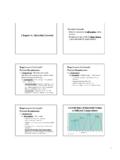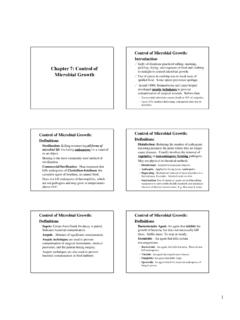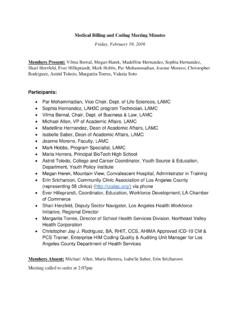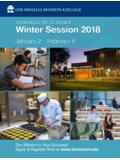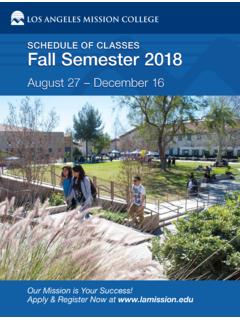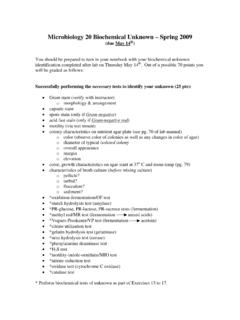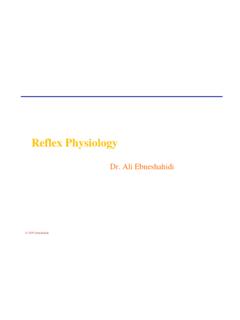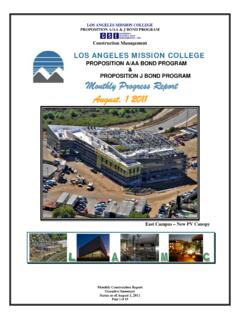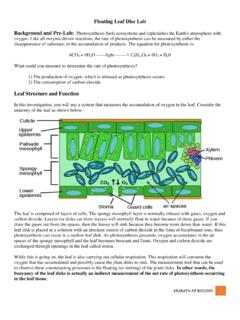Transcription of Chapter 5: Microbial Metabolism
1 Chapter 5: Microbial Metabolism1. Enzymes2. ATP Production3. Autotrophic Processes1. EnzymesBiochemical ReactionsAll living cells depend on biochemical reactions to maintain of the biochemical reactions in an organism are collectively referred to as Metabolism , which is of 2 basic types:catabolic: reactions that break down moleculesanabolic: reactions that build new molecules generally energy releasingor exergonic generally energy requiringor endergonic**exergonicreactions provide energy for endergonicones!**exergonicendergonicAll organisms, prokaryotic or eukaryotic, need to build the molecules they need, and find the energy to do so!
2 Metabolic PathwaysMost biochemical reactions are part of a series of reactions referred to as a metabolicpathway: pathways can be catabolicor anabolic each reaction is catalyzed by its own enzyme it usu. takes multiple reactions to make end-product Enzyme BasicsAlmost all biochemical reactions are catalyzedby a specific enzyme: proteins that accelerate the rate of a reactionwithout being changed themselves lower the activation energy (Ea) reactions won t occur unless the enzyme that catalyzes the reaction is present & active the need for enzymes provides a way to controlor regulate biochemical reactions**reactions won t occur unless the Earequirement is met**Enzymes lower the Activation EnergyEnzymes physically bind SubstratesControl of Enzyme ActivityBiochemical reactions can be controlled bychanges in enzyme activity, which can be influenced in several ways.
3 1) Changes in the amount of enzyme or substrate2) Changes in temperature, pH or [salt]3) Availability of any necessary cofactors4) Effect of inhibitors more enzyme &/or more substrate = more product! can effect enzyme structure, hence its activity some enzymes don t work w/o a non-proteincofactor molecules that bind to enzymes & reduce their activityFactors effecting Enzyme Activity Temperature reactions occurmore rapidly astemperature rises**as long as enzymeis active (heat can denatureenzymes)pH enzyme structuredepends on pH[Substrate] reactions occurmore rapidly as[substrate] rises**pH affects charge of R groups , protein structure**saturationoccurswhen [substrate]is high enoughEnzyme Denaturation enzymes are polypeptides that retain their abilityto function only when folded properly changes in temperature, pH or [salt]
4 Can disruptamino acid R group interactions causing theprotein to unfold, become denatured**mutations can also lead to misfolded, non-functional enzymes**Some Enzymes Require Cofactors can be a metal ion, vitamin, or other non-protein enzyme is inactive w/o cofactor if the cofactor is organic, it is called a coenzymeEnzyme Inhibition inhibitors can bind reversibly(can come off )or irreversibly(don t come off, poisons ) inhibitors bind enzymes in 1 of 2 ways: competitiveinhibition (binding to active site) allostericinhibition (binding elsewhere, changing shape)Feedback InhibitionThe end-products of metabolic pathwaysare important reversibleenzyme inhibitors inhibit 1stenzyme in pathway,turning the pathway off provide an important way ofregulating end-product levels can be competitive or allosteric inhibitionlow [inhibitor] = pathway ONhigh [inhibitor] = pathway OFF2.
5 ATP ProductionAdenosine Triphosphate (ATP)Preferred source of useableenergy for ALL cells: breaking bond of 3rdphosphate releases ideal amt of energy bond is easily broken (low Ea)**This is why organisms convert food energy to ATP energy**How is ATPproduced? In most organisms, energy from a food source is converted to energy in ATP by glycolysisfollowed by 1 of 2 processes: FERMENTATION(low ATP yield)RESPIRATION(high ATP yield)orGlycolysis Glycolysis is a catabolicpathway by whichsugars such as glucose(& several other food sources) are broken down to two 3-Carbon molecules of pyruvicacid (or pyruvate): Don tmemorizethis!
6 ! releases energy to yield 2 ATP per glucose also transfers high energy electrons (+ H) to NAD+toyield 2 NADHO xidation/Reduction Much of the energy in food molecules such as glucose is captured as high energy electrons (e-) by electron carriers such as NADH & FADH2 when a molecule receivesor gains electrons it is said to be reduced a molecule that gives upelectrons( , loses H)is said to beoxidized**e-are typically transferred as part of a Hydrogen atom** NAD+NADHF ermentationFermentation is all aboutrecycling NAD+so that glycolysis can continue: NAD+NADHATP production begins & ends with glycolysis in organisms that ferment.
7 Glycolysisfermentation NADH is oxidized to NAD+by reducing pyruvate tolactic acid for exampleDifferent Fermentation ProductsDifferent organisms recycle NAD+in different ways, resulting in a variety of fermentation end-products.*Respiration After glycolysis, energy inpyruvate & NADH is used to produce much more ATP by respiration:KREBS cycle breaks down pyruvate to 3 CO2, energy captured ase-by NADH & FADH2 ELECTRON TRANSPORT e-from NADH, FADH2usedto produce H+gradientCHEMIOSMOSIS H+gradient used to makeATPThe Krebs cycle a cyclical metabolicpathway catalyzed byenzymes in the matrixof mitochondria requires 2-C acetylgroups connected to coenzyme A (acetyl-CoA)(3-C) pyruvate + CoA(2-C) acetyl-CoA + CO2(Krebs cycle )Electron Transport & ChemiosmosisOccurs in the mitochondria of eukaryotes and at the plasmamembrane of prokaryotes.
8 Oxygen (O2) is usually the final electron acceptor, butother molecules can play this role in anaerobicrespirationLipid & ProteinCatabolism Lipids and proteins canalso be used as sources of energy to produce ATP different amino acids enter glycolysis or the Krebs cycle at various stages fatty acids are brokendown to acetyl groups & fed into the Krebs cycleSummary of ATP ProductionObligate aerobes: aerobic respiration (& brief periods of fermentation)Facultativeanaerobes: can survive via aerobic respiration OR fermentationObligate anaerobes: fermentation or anaerobic respiration3. Autotrophic ProcessesAll organisms depend on AutotrophsAutotrophs can produce organic molecules from CO2, an inorganic carbon source.
9 All heterotrophs require an organic source of carbon organic molecules, directly or indirectly, come fromautotrophsThe source of energy for autotrophic processescan be:LIGHT: photoautotrophs that carry out photosynthesisCHEMICAL: chemoautotrophs that use various molecules as a source of high energy e-Light Reactions of Photosynthesis Electrons (from H2O) energized by sunlight: fuel the synthesis of ATP through electron transport &chemiosmosis (much like respiration) ultimately reduceNADP+to NADPH ATP & NADPH provide energyto fuel productionof sugars in the dark reactions Dark ReactionsDon tmemorizethis!
10 !Involves an anabolicpathway known as theCalvin-Benson cycle : endergonic reactions ofthis pathway are fueled byATP & NADPH from the light reactions resulting sugars can beused as a source ofenergy or to build otherorganic moleculesSummary of EnergyMetabolism Key Terms for Chapter 5 activation energy, substrate, active site feedback inhibition: competitive vs allosteric cofactor vs coenzyme, denatured glycolysis, fermentation, respiration catabolic, anabolic; exergonic, endergonic Krebs cycle , electron transport, chemiosmosis oxidation vs reduction calvin -Benson cycleRelevant Chapter Questions rvw: 1-7, 18, 20-22 MC: 1, 4-10
